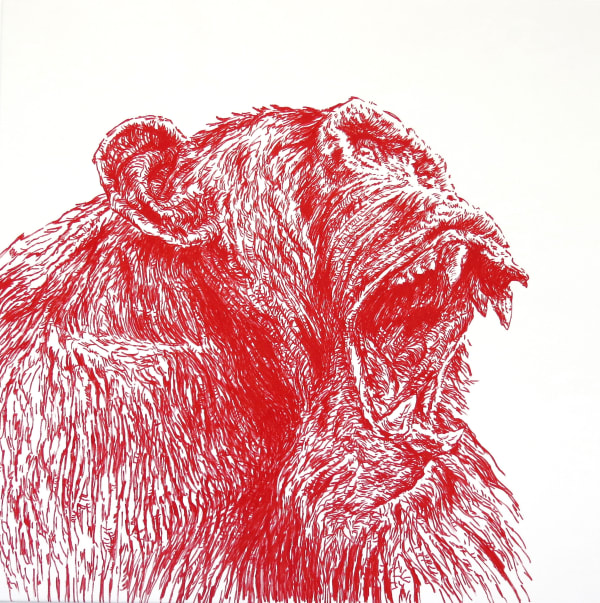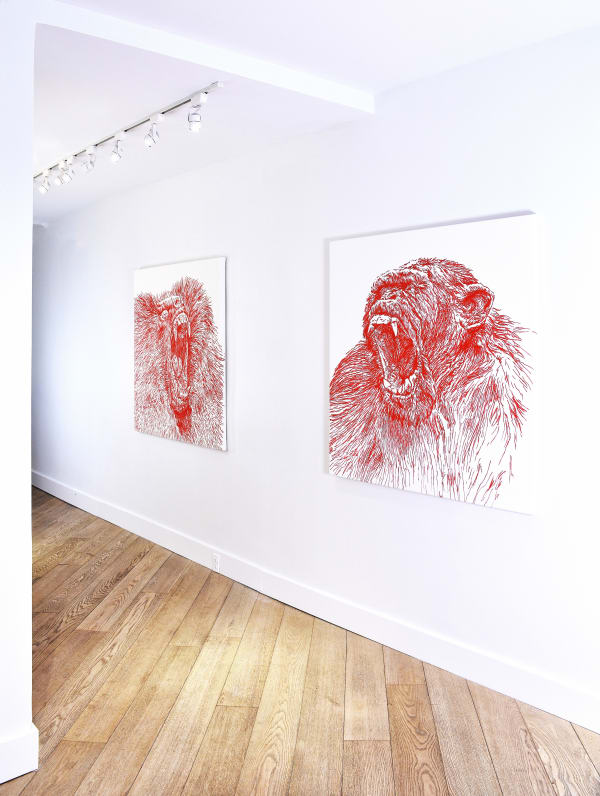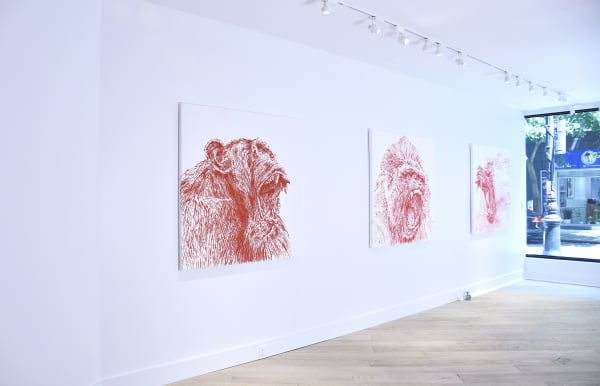Torn Canvas Project: William Pérez
Embodying transformation, in a multimedia conceptual piece consisting of red acrylic drawings on canvas, each displaying raw emotion, William Pérez explores restlessness with his creative process, rebelliousness against inertia, and a desire for radical change.
Thomas Nickles Project is pleased to present Torn Canvas Project, William Pérez’s first solo exhibition with the gallery. Characterized by diversity, curiosity and inventiveness, Pérez’s work embodies transformation. Recognizing and honoring his desire and duty to evolve and embrace change has led him to experiment with numerous media and techniques throughout his career including small installations in wood and metal, watercolor, stencil, cold drawing on canvas, large interactive installations, incised Plexiglas, fiber optics, resin and wire sculpture, and robotics.
Determined to live where he could promote his own evolution, Pérez settled permanently in the New York City area in 2017. This decision would mark, as only emigration can, the voice of the artist. Drawing in its purest form became an exercise of reorientation, enabling the process of letting go of the past and assimilating to a new reality. Caprichos de la Conciencia (Whims of Conscience), a series developed between 2018 and 2019, began with small format works in red ink on cardboard and took on the form of a personal map, a way of populating the city, of projecting – in the halls of the Metropolitan Museum and the Guggenheim and in subway stations – the personal fantasy of belonging.
Describing the experience, the artist stated: “For the first time, these spaces that legitimize the coexistence of infinite cultures, concepts, and energies began to feel like they were spaces of my own. This sense of belonging provoked in me a certain irreverence — I started installing my own images in the context: bondage figures, levitating human hearts, bison, and peacocks.” The seriesculminated with large scale canvases in red acrylic, the color a manifestation of the disturbances and intensity of the moment, which as evidenced by the work on display, extended to Torn Canvas Project.
Restlessness with his creative process and rebelliousness against any form of inertia began taking hold at this moment, demanding a channel of expression. “Three years ago, a year before the pandemic, I told a friend I felt saturated and was ready to burn or tear all my finished works. For some time now, the uncontrollable and risky desire has been brewing to assume a radical change (…)” theartist explains. On a pedestal in the front of the main space and installed in multiples on the south wall at the back of the gallery, fragments constituting the final physical form of this ‘radical change’ are on view, all part of Torn Canvas Project No. 1, a multimedia conceptual work that progresses from an acrylic drawing on canvas to a performance piece and concludes as a fragment/sculptural artifact, all captured in a documentary video also on display.
The aesthetic value of the initial work on canvas, in this case, is not the priority for Pérez, he is focused on the moment of transformative action and the participation of the spectator in the evolutionary process of the work and its performance. The process goes beyond the image, as he explains, “the work has two lives — it is born, later dies, and become resurrected as a completely different work with new meaning… transcending beyond traditional aesthetic value — a critical part of the piece is in fact the phenomenon of action and the involvement of spectators with that moment of action.” He cuts the 100 x 300 inch finished canvas into 60 equal vertical strips with a knife, signs and numbers them, carefully rolls and mounts the individual strips/fragments in a separate Lucite box, each now an independent work with its own destiny and purpose. The change, the transformation from one state to another, makes this work a bridge between painting, sculpture, installation, and performance and therein lies the artist’s true objective: to develop, in front of our astonished eyes, which would perhaps prefer the original drawing to remain intact, the capacity of transformation, of the evolution of an idea, and with it, the potential of adaptation to new values within ourselves.
In the video, the imagery of Torn Canvas Project No. 1 is visible — a dramatic display of emotion in its purest form with expressive red lines tracing the gestures of the faces and sharp fangs of three simians. This ferocity pervades throughout the exhibition in fully intact works on canvas, five of medium scale and one larger, all from the Living Nature Series, part of Torn Canvas Project. Each is a passionate expression, a release. The calm expression of Chimpanzee 2, a second large work on canvas, offers a counterpoint. Pérez expands on the origins of the imagery, “I started drawing apes around the same time I was drawing small self-portraits, based on photos taken from my cellphone…The fixed and calm gaze of the apes and my pose, conditioned by the imprint of the moment, made me realize that at times, nature makes a call for attention.” As humans we are conditioned to normalize what is happening around us, repressing our emotions. That is how the angry ape and monkey imagery was born—they are irreverent, their existence a showcase of primitively uncontaminated emotions and actions, making themselves seen in a call for attention, perhaps an acknowledgment of the bewilderment of being alive.
The project is also a reflection on the complex reality of Cuba and Cubans. The imagery represents a reaction to recent events in the country where cultural and political censorship are still daily realities, and Pérez explains, “silencing every attempt at autonomy has eradicated the universal right to harmonize with nature in a just society.” The result, a drained island where emigration is massive and constant and that like Torn Canvas Project is a fragmented reality, whose pieces will remain scattered. The 60 final works can also migrate out into the furthest reaches of the globe. By documenting the stewards and destination of each piece and keeping all the participants connected, William is also shaping a network of his own, in which to recognize himself in the multiplicity. He is in effect, creating an extended version of his territory, which like the Cuban diaspora we find a vibrant and moving notion.













